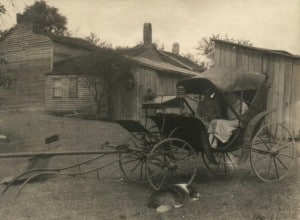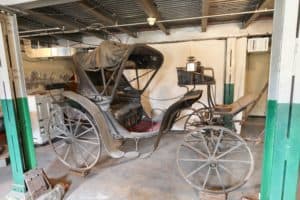
In 1873, perhaps feeling flush with royalties from his book The Fair God, Lew Wallace ordered a new carriage. It was a made-to-order French Victoria Carriage that cost $1,000, with an additional $200 for shipping. At this same time, Lew and Susan constructing their new Carriage House immediately north of their home.
The Carriage
The body sits relatively low. One forward-facing seat can accommodate two passengers. An iron frame supports a raised driver’s seat supported. A calash top (one that folds back in accordion style) covers the seats. Mounted brass lanterns and a whip holder affix in front, adjacent to the driver’s seat. Behind the main seating there is a footman’s seat.
The wheels all possess expensive brass boxings (a part of axle and hub connections). The two removable front wheels could attach to another body to make a two wheeled cart. The carriage has leather curtains, cushions, and fenders. With a simple conversion, this one-horse buggy could be pulled by a beautiful matched pair of horses. The removable front driver’s seat allowed the driver to sit in the main compartment of the carriage.
Phaetons
A carriage of this general form might have been called a phaeton in the early 19th century. These sporty, open conveyances could be drawn by a single horse or a pair. Typically phaetons possessed four extravagantly large wheels, very lightly sprung. The design features a minimal body, making it fast and even dangerous. Phaetons usually had no sidepieces in front of the seats.
The name derives from the disastrous ride of the mythical “Phaëton,” son of Helios. He nearly set the earth on fire while attempting to drive the chariot of the sun. American phaetons often had a higher carriage of light construction, with a covered seat in front and a footman’s seat behind, like Wallace’s.
 The Victoria version was an elegant French carriage. The design drew on a phaeton made for King George IV, who ruled Great Britain until 1830. People started calling this kind of carriage a Victoria around 1869. At that time, Prince Albert imported one to England for his wife, Queen Victoria. As a result of its association with the Queen, these carriages became very popular with the wealthy in the late 19th century.
The Victoria version was an elegant French carriage. The design drew on a phaeton made for King George IV, who ruled Great Britain until 1830. People started calling this kind of carriage a Victoria around 1869. At that time, Prince Albert imported one to England for his wife, Queen Victoria. As a result of its association with the Queen, these carriages became very popular with the wealthy in the late 19th century.
After Wallace’s Death
Wallace owned this carriage for over 30 years. He probably did not retire it from service until after purchasing his Waverly electric automobile around 1900. In 1915, ten years after his death, Frank Oliver of Crawfordsville purchased it for his mother. Sometime after her death, Oliver returned it to the Study. Over the years it was exhibited at community gatherings across Indiana and around the country. It also starred at the Indiana State Fair several times. Years ago, some enterprising person disassembled the carriage and moved it to the basement of the Study, where it continues to be on display.
To see a phaeton in action, each June, during the official “Queen’s Birthday” celebrations, Queen Elizabeth II travels to and from Trooping the Colour Horse Guards Parade in an ivory-mounted phaeton carriage made in 1842 for her great-great-grandmother, Queen Victoria. In this country, another vehicle carries on the tradition of Wallace’s French Victoria Carriage if in name only—the Ford Crown Victoria.
One thought on “Lew Wallace’s Carriage”